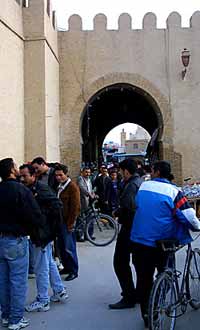|
t r a v e l s n a p zT r a v e l t h e w o r l d f o r j u s t a f e w c l i c k s |
||||
Guestbook |
Kairouan, the Holy City |
|||

One of the entrances to the medina of Kairouan. |
Maybe the louage driver thought that our souls needed saving
quickly - our journey from Gabes to Kairouan, Tunisia's holy
city, was at an average speed of around 150 kilometres per
hour.
|
 In Kairouan, a convenient place to stay near the central medina is Hotel Tunisia in Avenue de la Republique, telephone 77 231 855. You won't break the bank and the rooms are clean. |
When you leave the Great Mosque (avoiding the carpet salesman who is inviting you up to his terrace to enjoy the view), you can stroll outside the medina to visit the graves of the Prophet's ancestors - they are nicely whitewashed against the brown of the medina wall.
We walked away from the medina for a few blocks to see the Bassin des Aghlabites, the site of the original water system that the Romans installed to supply water to this city that would otherwise be a dustbowl (I'm sure that Oqba Ibn Nafaa also took account of these facilities when deciding where his headquarters would be).
Thomas K of USA writes: "I was stationed near Kairouan with the 82nd. Airborne Div. in late 1943. It was hot and dry. There was lots of olive trees there, large cactus rows there also. We would go to the coast and enjoy the water. We left there and went to Bizerte."
Other Tunisian places
on Travelsnapz:
Bizerte
Djerba
Dougga
Le Kef
And just down the road is the mosque and mausoleum of Sidi Sahbi the barber - so called because he carried three hairs from the Prophet's chin around in his pocket. You can get a splash of holy water here too (a tip is expected) but the lovely columned courtyard and the beautifully decorated walls are worth the price.
Back to the medina, and you can wander through the forest of market stalls and the quieter residential areas. There is a beautifully restored Pasha's house (now a government carpet shop, but this means that you can wander freely through the impressive building albeit with a carpet salesman on your elbow). Next door to the Pasha's House is the Mosque of Sidi Abid el Gherieni, also worth a visit. The caretaker of the mosque will show you the living quarters that used to be occupied by students studying Islam (a role now taken over from the mosques by the universities).
A short stroll further on and you will come to the Mosque of the Three Doors, which is notable because of the Koran verses carved into the exterior sandstone wall. This mosque used to be the base of the now outlawed Assoiu Brotherhood, a Sufi sect known throughout North Africa for violent trance induced rituals.
It is worth continuing your journey through the narrow lanes as they twist and turn past the houses and workshops, flowing into little squares, to dart off again to another part of the medina.
As you walk through the city, don't be surprised by the local custom of hanging the head of the beast that has just been killed outside the butcher shop - just ask yourself "could I look it in the eye as I am buying my Sunday roast?"